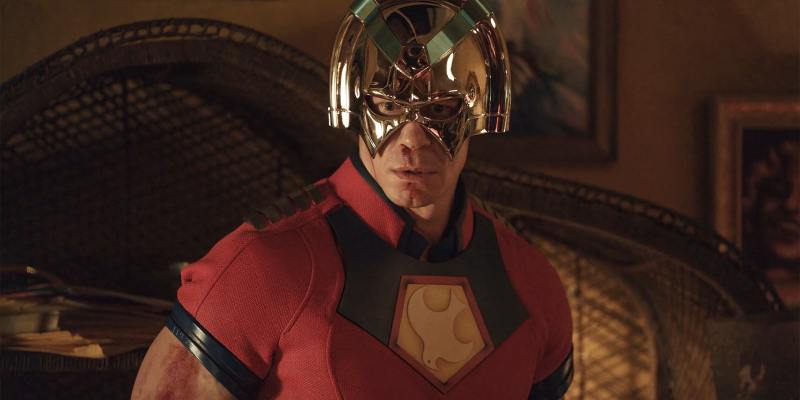This discussion and review of the first three episodes of Peacemaker on HBO Max, including “A Whole New Whirled,” “Best Friends, for Never,” and “Better Goff Dead,” contains some spoilers.
Peacemaker is saturated with nostalgia for the 1980s.
This isn’t a surprise. Showrunner James Gunn was a teenager during the decade. His earlier films are similarly nostalgic for the era. In Guardians of the Galaxy, Peter Quill (Chris Pratt) is abducted from Earth in 1988. In Guardians of the Galaxy Vol. 2, Peter’s mysterious father Ego is played by 1980s action icon Kurt Russell. Gunn has worked with one of the decade’s other action powerhouses, Sylvester Stallone, on both Guardians of the Galaxy Vol. 2 and The Suicide Squad.
Much of the mythology of Peacemaker is drawn from the comics of the 1980s. The character originated as part of Charlton Comics in November 1966 but was folded into the DC universe when that company acquired Charlton Comics in 1983. Peacemaker arguably enjoyed the peak of his popularity in the 1980s. He served as the inspiration for the Comedian in Alan Moore and Dave Gibbons’ classic Watchmen. He held down his only solo series at DC between January and April 1988.
It isn’t just Peacemaker (John Cena) himself. The mythology of the show draws heavily from the comics of the era. The series is a spin-off from Gunn’s film The Suicide Squad, itself drawing from John Ostrander’s iconic Suicide Squad run that kicked off in May 1987. It features Freddie Stroma as Adrian Chase, the superhero known as Vigilante. Chase first appeared in an issue of New Teen Titans in September 1982 and held down his own ongoing title from November 1983 to February 1988.
Even the smaller touches take their cues from the decade’s comics. At the end of the second episode, it is revealed that Peacemaker’s father, Auggie Smith (Robert Patrick), had his own alternate identity as the White Dragon. This is a fairly deep cut from comic book lore. The White Dragon was a white supremacist supervillain who first appeared in the fourth issue of Ostrander’s Suicide Squad, published in August 1987.

Peacemaker is rooted in the 1980s in other ways. The show’s opening credits play like a music video from the era, featuring a synchronized dance from the ensemble on a set that could easily have appeared on the short-lived Top of the Pops USA that ran briefly on CBS in 1987 and 1988. At one point, Peacemaker pauses while browsing a companion’s vinyl collection to recall seeing ’80s British rock band the Quireboys perform live.
There’s a lot of nostalgia for old media to be found in Peacemaker. The climax of the first episode features a fight set to a soundtrack on vinyl. Helping clean up Peacemaker’s dilapidated trailer, Vigilante finds an old VHS lying around. The technical support squad around Peacemaker sets up in what John Economos (Steve Agee) describes as “the worst HQ of all time,” which is a rundown and abandoned old video rental store.
This 1980s influence extends beyond the general aesthetic of the show. It is reflected in the characters themselves, in particular the way that the series approaches masculinity. In the opening episode, Peacemaker tries to convince a hospital janitor (Rizwan Manji) that he is a superhero. The janitor is unconvinced, remarking that Peacemaker is “kind of bulky” and that he cannot be a superhero because “all superheroes have a gymnast’s body.”
This sets up a juxtaposition. Modern superheroes are incredibly toned and muscled, but they are also expected to be lean. Hugh Jackman would dehydrate himself for 36 hours before shirtless scenes in the X-Men movies, and Henry Cavill has talked about adopting a similar approach for The Witcher. It’s a process known as “shredding,” which is as much about shedding mass as it is about gaining muscles. Sirin Kale describes it as “a cosmetic muscularity, rather than a functional one.”

John Cena has a different body type than most contemporary superhero movie leads. He is bigger and bulkier. Gunn frequently shoots Cena in such a way as to emphasize this different sort of masculine ideal; both The Suicide Squad and Peacemaker feature sequences of the character in his tighty whities, while his brightly colored costume is designed to emphasize his muscle mass. Early in the show’s second episode, the character even struggles to get his shirt on.
As such, Cena’s body evokes an older masculine ideal. It feels like a product of the “hard bodies” era, evoking 1980s action icons like Sylvester Stallone or Arnold Schwarzenegger. It is perhaps revealing that Gunn cast Robert Patrick as the protagonist’s father, with Patrick’s most iconic screen role remaining the wiry and villainous T-1000 opposite Schwarzenegger’s muscled body in Terminator 2: Judgment Day. However, Gunn isn’t just evoking 1980s masculinity. He is engaging with it.
“In the 1980s, the action genre was defined primarily by one thing: the myth of the American man,” writes an overview of the era on HDNet. “The films operated on the notion that one man, a pinnacle of physique, would be the savior, and that strength, guts, and glory were the resolution to any challenge these characters would face.” In some ways, The Terminator was the culmination of this trend, turning the idealized male body into a literal machine untroubled by pain or emotion.
In the third episode, Senator Goff (Antonio Cupo) tortures the captured Peacemaker and Vigilante for information. Notably, he doesn’t even try to physically harm Peacemaker, whom he identifies as “the alpha” of the team. The idea is that Peacemaker can take the physical pain. The joke of the scene becomes Peacemaker’s ability to endure the torture of Vigilante, his lack of empathy and his refusal to break even as another person suffers in front of him.

As such, Peacemaker interrogates this old-fashioned idea of American masculinity. Peacemaker is often physically subdued by opponents much smaller than he is. The first episode finds the character crawling pathetically through a parking lot to evade an opponent half his size. Peacemaker spends most of the third episode ridiculing the diminutive Judomaster (Nhut Le), only for Judomaster to handily defeat both Peacemaker and Vigilante.
More to the point, Peacemaker contrasts the character’s physicality with his lack of emotional strength. Cena is a charming physical performer, and Peacemaker presents its lead as weirdly vulnerable. In the opening episode, he has to timidly sneak out of a hospital, trade his “beacon of freedom” helmet for a taxi ride, and break into his own trailer because he can’t find his keys among the empty beer cans in his garden.
It becomes clear that Peacemaker is emotionally stunted, in no small part due to his troubled relationship with his father. In the second episode, believing himself alone, Peacemaker begins to cry and demean himself in bed. “Everybody fucking hates you,” he tells himself. His response to this emotional outburst is physical violence towards himself; he slaps himself in the face to straighten up. He confesses to being confused about having “feelings about things.”
Peacemaker understands that modern masculinity needs to be more flexible and more emotionally available. Even the team’s mysterious leader, Clemson Murn (Chukwudi Iwuji), is more open about his feelings than Peacemaker. He confesses to Economus that he had “never shared a feeling” before, but that he is trying to become “a deeper, more rounded individual.” Being willing to express vulnerability to other people is part of this maturity for Murn.

There’s a compelling contrast there, between the machismo that Peacemaker presents to the world and his inability to engage emotionally. The character’s coworkers see him as pathetic; Emilia Harcourt (Jennifer Holland) calls him a “piece of shit” and Economus describes him as “a dick,” while Leota Adebayo (Danielle Brooks) simply remarks that he seems “sad.” Murn realizes that Peacemaker’s underlying insecurity, and his inability to express it, make him easy to manipulate.
Even three episodes into the season, Peacemaker is capable of change. It makes sense thematically that the character has been assigned to “Project: Butterfly,” a name that suggests transformation. An early establishing shot foregrounds a caterpillar to underscore the point. Peacemaker is not the man he was. In the third episode, Peacemaker finds himself unable to murder children at Murn’s order. “Waller gave us a killer who can’t kill,” Murn laments. If he is not a killer, what is he?
Peacemaker is a fascinating interrogation and exploration of an old-fashioned ideal of American masculinity, one very consciously rooted in nostalgia for the 1980s. However, Gunn uses that iconography to engage with interesting questions around modern masculinity. The show is off to a tremendous start.
